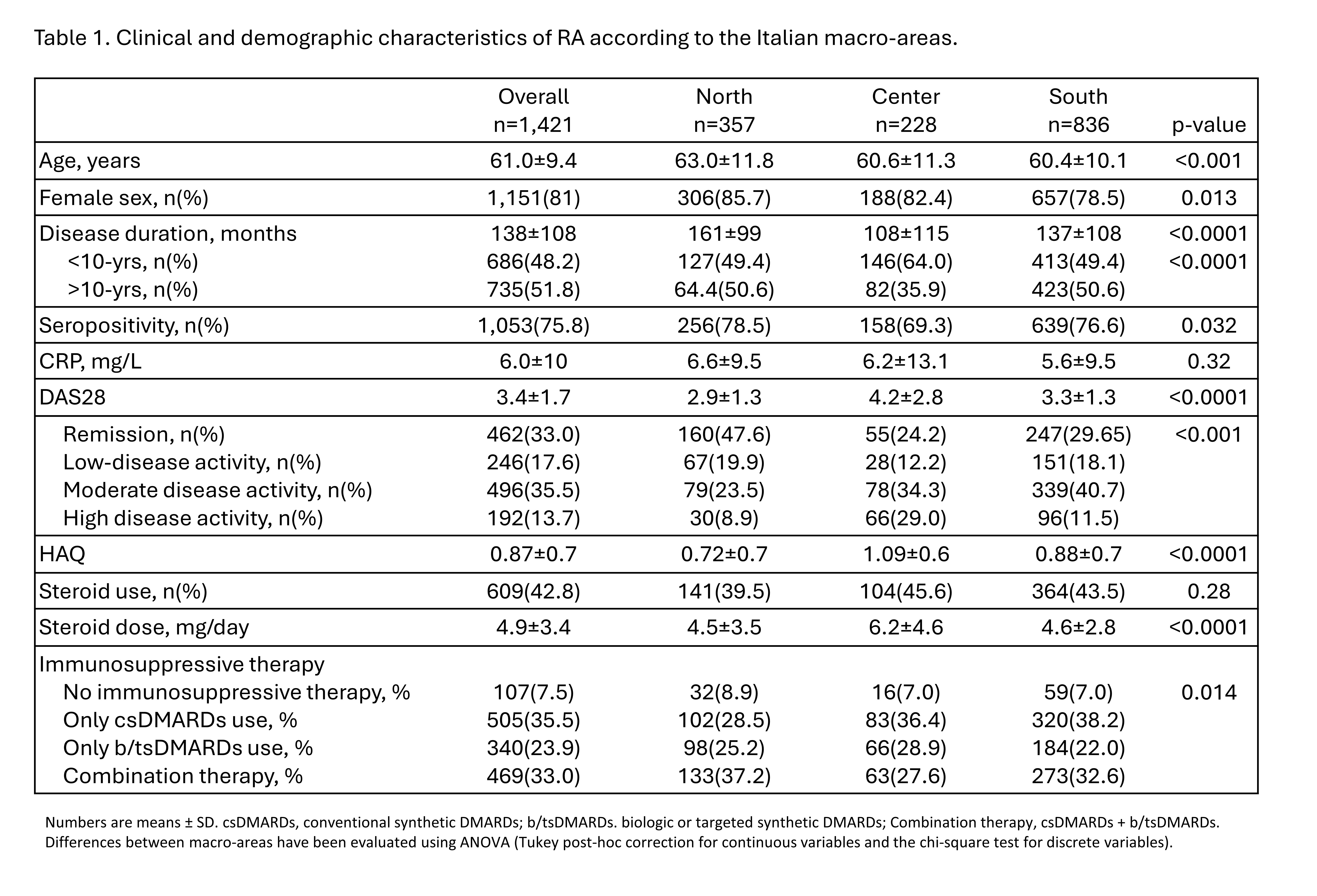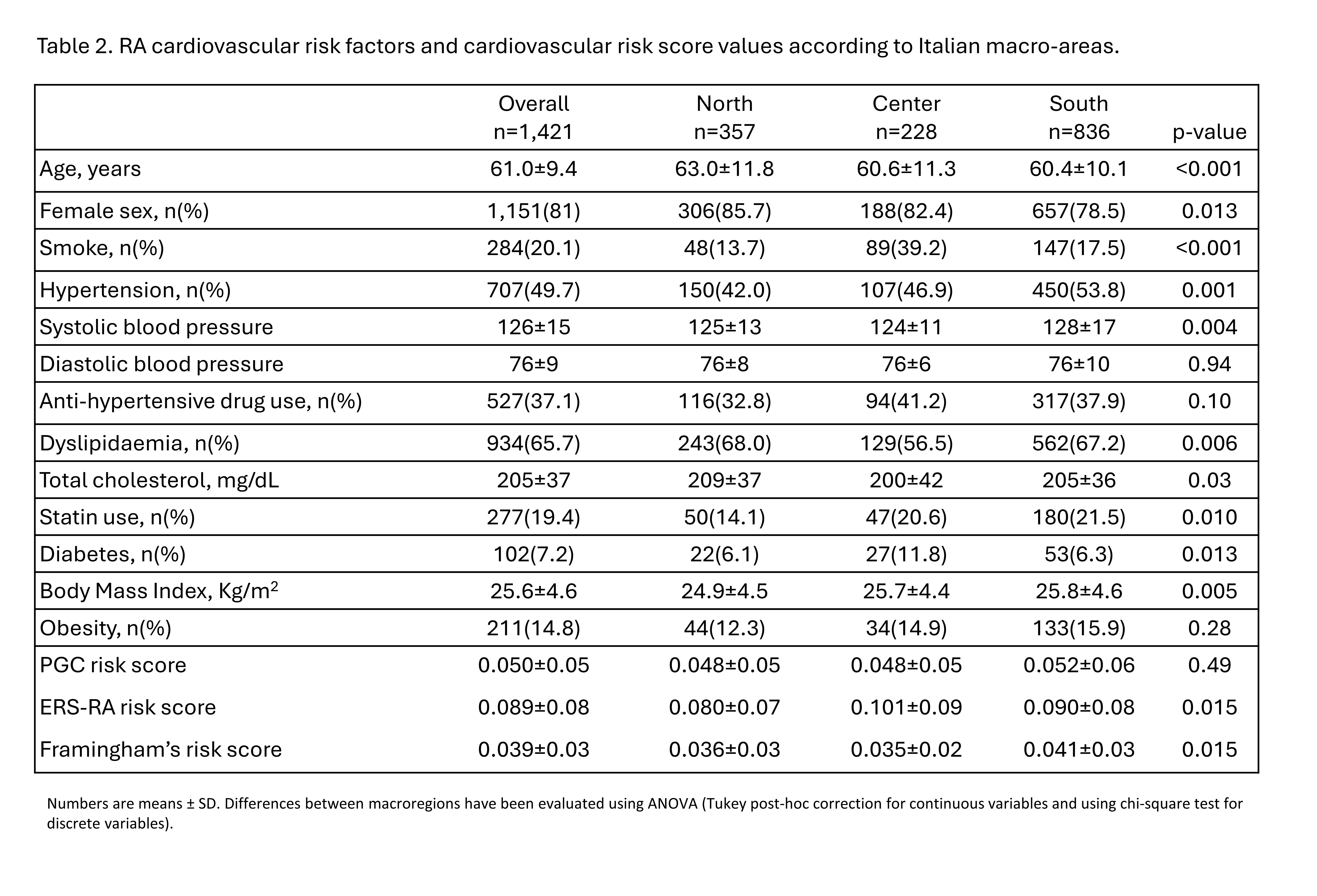Session Information
Session Type: Poster Session A
Session Time: 10:30AM-12:30PM
Background/Purpose: Geographic origins can significantly impact people’s health, particularly in Italy, where regional health disparities are among the most pronounced [1]. Rheumatoid arthritis (RA) is characterized by increased cardiovascular (CV) disease comorbidity. Traditional CV risk factors in RA patients are more closely related to surrogate CV disease markers than inflammatory indices [2]. This study aimed to compare the prevalence of CV risk factors and the cardiovascular risk score values among groups of RA patients from different macro-areas in Italy.
Methods: This study is a cross-sectional analysis of a longitudinal cohort of 1,421 adult RA patients (357 from the North, 228 from the Center, and 836 from the South of Italy). Several types of information were collected, including demographics, clinical assessments, smoking habits, Body Mass Index (BMI), total cholesterol levels, arterial hypertension, dyslipidemia, use of antihypertensive drugs and statins, obesity (BMI ≥30), and diabetes. The ‘Progetto Cuore’ (PGC), ERS-RA, and Framingham risk scores were also evaluated.
Results: RA patients in the North of Italy are older and have a prolonged disease duration but have lower disease activity (DAS28) and higher remission rates (Table I). Overall, the most prevalent CV risks were dyslipidemia (65.7%) and hypertension (49.7%). When comparing RA patients among the three macro-areas, hypertension was significantly more prevalent in the South (53.8%, p=0.001), and dyslipidemia was less prevalent in the Center (56.5%, p=0.006). At the same time, statin use was less common in the North (14.1%, p=0.010). Although obesity prevalence did not differ among the three macro-areas, BMI values were significantly lower in the North. Regarding health habits, smokers were significantly more prevalent in the Central regions (39.2%, p< 0.001). The ERS-RA and Framingham risk scores, but not the PGC algorithm, significantly differed across Italian regions (Table II).
Conclusion: This study suggests that geographical differences in Italy may influence the CV risk profile in RA patients. Different genetic backgrounds, lifestyles, and dietary habits may explain the observed differences. Further research is needed to assess how geographic and sociocultural factors contribute to CV risk and to develop targeted strategies to improve CV outcomes.
References.
1. Franzini L, Giannoni M. BMC Public Health. 2010;10:296.
2. Sandoo A, et al. Arthritis Res Ther 2013;15:R203.
To cite this abstract in AMA style:
Atzeni F, Cacciapaglia F, Bartoloni Bocci E, Piga M, Sakellariou G, Viapiana O, Giollo A, PARISI S, Chimenti M, Favalli E, Corrado A, Celletti E, Giovannini I, Guiducci S, Gremese E, Manfredi A, Spinelli F, Erre G. Estimation of 10-year Cardiovascular (CV) Risk and Traditional CV Risk Factors Distribution in Patients with Rheumatoid Arthritis from Three Italian Macro-areas [abstract]. Arthritis Rheumatol. 2024; 76 (suppl 9). https://acrabstracts.org/abstract/estimation-of-10-year-cardiovascular-cv-risk-and-traditional-cv-risk-factors-distribution-in-patients-with-rheumatoid-arthritis-from-three-italian-macro-areas/. Accessed .« Back to ACR Convergence 2024
ACR Meeting Abstracts - https://acrabstracts.org/abstract/estimation-of-10-year-cardiovascular-cv-risk-and-traditional-cv-risk-factors-distribution-in-patients-with-rheumatoid-arthritis-from-three-italian-macro-areas/


